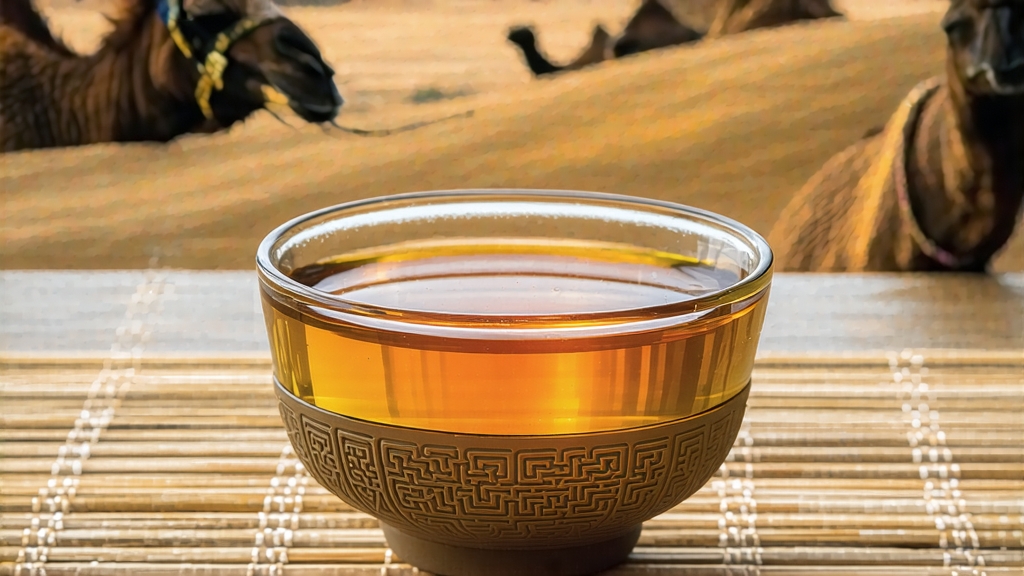
If green tea is the fresh-faced scholar of Chinese tea culture, then Fu brick tea (Fú zhuān chá) is the weathered caravan leader who once guided camel trains across the Gobi, carrying bolts of silk and pressed bricks of leaf that would mellow into liquid gold. Produced almost exclusively in Hunan’s Anhua county, Fu brick is the most aromatic and scientifically intriguing member of the dark tea (hēi chá) family. Its name comes from the old practice of shipping the tea during the hottest “fu days” of summer, when the combination of heat and humidity triggers a spectacular bloom of beneficial molds that look like tiny golden stars. To international drinkers who have only met pu-erh, Fu brick offers a softer, sweeter, and unexpectedly floral counterpoint—yet it is every bit as complex, and arguably more forgiving in the teapot.
A 600-year journey from frontier currency to laboratory curiosity
Dark tea was born from necessity. During the Ming dynasty (1368-1644), court officials needed a way to move large volumes of tea to the horse-trading markets of the north-west without the leaf spoiling on the month-long trek. Pressing the tea into dense bricks reduced volume and breakage, while the natural fermentation that occurred en route mellowed its harshness and lowered its caffeine bite. By the early 1600s, Anhua county had become the imperial workshop for these bricks, and the town of Ya’an served as the gateway through which they flowed onto the Tea-Horse Road. Caravans measured distance not in kilometres but in “tea stops,” and a single Fu brick could be subdivided like currency, each 50-gram slice buying fodder, lodging, or information. In 2010, a 19th-century Fu brick surfaced at a Paris auction; its paper wrapper still bore the soot of Tibetan hearths, and the bidding ended at €22,000—testament to the tea’s trans-continental charisma.
Microscopic gold: what “golden flowers” really are
The signature of authentic Fu brick is the brilliant yellow speckling visible when you snap a brick in half. These are colonies of Eurotium cristatum, a harmless mold that Chinese texts poetically call “golden flowers” (jīn huā). Far from being spoilage, the mold is cultivated as carefully as a vintner nurtures yeast. Within 72 hours of pressing, the brick’s interior climbs to 28 °C and 78 % relative humidity—conditions that persuade the spores to germinate. Over the next 12 days they weave a honeycomb network, secreting enzymes that convert polyphenols into theabrownins and split bulky starches into mellow, malty sugars. Laboratory analyses at Hunan Agricultural University show that the golden flowers also generate a unique metabolite, PQQ (pyrroloquinoline quinone), an anti-oxidant previously unknown in the tea kingdom. The result is a liquor that tastes of honeyed apricot, wet autumn leaves, and a faint suggestion of sandalwood incense—nothing like the earthy basement notes often associated with dark tea.
From leaf to brick: a craft that still follows the lunar calendar
Fu brick production begins on the Qingming festival, when the first spring rains coax the local Yun Tai Da Ye cultivar to bud. Pickers pluck one tender leaf plus the adjacent mature leaf—the ratio that gives later sweetness while providing enough cellulose for microbial dinner. The leaves are wilted under mountain shade for four hours, then “killed-green” in a 280 °C wok for exactly 90 seconds, hot enough to denature enzymes yet preserve surface microbes. A 45-minute mechanical rolling ruptures cells, after which the leaf is piled 70 cm deep inside bamboo steamers. This “wet piling” (wò duī) lasts 8–10 hours and is the first fermentation, darkening the leaf to the colour of bitter chocolate. Once dried to 14 % moisture, the leaf is ready for the bricking room, a space that smells like fresh hay and sounds like a heart-beat: wooden presses thud every three seconds, squeezing 2 kg of leaf into a steel mold the size of a hard-back book. The crucial step follows—wrapping the bricks in cotton paper and stacking them inside a 35 °C “flowering room” where the golden bloom occurs. Masters judge readiness